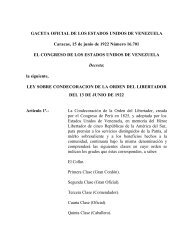Transverse waves on a string - People.fas.harvard.edu
Transverse waves on a string - People.fas.harvard.edu
Transverse waves on a string - People.fas.harvard.edu
Create successful ePaper yourself
Turn your PDF publications into a flip-book with our unique Google optimized e-Paper software.
slope = dψ/dx<br />
Figure 20<br />
v y = dψ/dt<br />
20 CHAPTER 4. TRANSVERSE WAVES ON A STRING<br />
Power<br />
What is the power transmitted across a given point <strong>on</strong> the <strong>string</strong>? Equivalently, what is the<br />
rate of energy flow past a given point? Equivalently again, at what rate does the <strong>string</strong> to<br />
the left of a point do work <strong>on</strong> the <strong>string</strong> to the right of the point? In Fig. 20, the left part<br />
of the <strong>string</strong> pulls <strong>on</strong> the dot with a transverse force of Fy = −T ∂ψ/∂x. The power flow<br />
across the dot (with rightward taken to be positive) is therefore<br />
P (x, t) = dW<br />
dt = Fy dψ ∂ψ<br />
= Fy<br />
dt ∂t = F vy =<br />
<br />
−T ∂ψ<br />
∂x<br />
<br />
∂ψ<br />
. (52)<br />
∂t<br />
This expressi<strong>on</strong> for P (x, t) is valid for an arbitrary wave. But as with the energy density<br />
above, we can simplify the expressi<strong>on</strong> if we c<strong>on</strong>sider the special case of single traveling wave.<br />
If ψ(x, t) = f(x ± vt), then ∂ψ/∂x = ±(1/v)∂ψ/∂t. So we can write the power as (using<br />
T/v = T/ T/µ = √ T µ ≡ Z)<br />
P (x, t) = ∓ T<br />
v<br />
2 ∂ψ<br />
∂t<br />
=⇒ P (x, t) = ∓Z<br />
2 ∂ψ<br />
= ∓vE(x, t) (53)<br />
∂t<br />
where we have used Eq. (51). We see that the magnitude of the power is simply the wave<br />
speed times the energy density. It is positive for a rightward traveling wave f(x − vt), and<br />
negative for a leftward traveling wave f(x+vt) (we’re assuming that v is a positive quantity<br />
here). This makes sense, because the energy plot in Fig. 19 just travels al<strong>on</strong>g with the wave<br />
at speed v.<br />
Momentum<br />
A wave <strong>on</strong> a <strong>string</strong> carries energy due to the transverse moti<strong>on</strong>. Does such a wave carry<br />
momentum? Well, there is certainly n<strong>on</strong>zero momentum in the transverse directi<strong>on</strong>, but it<br />
averages out to zero because half of the <strong>string</strong> is moving <strong>on</strong>e way, and half is moving the<br />
other way.<br />
What about the l<strong>on</strong>gitudinal directi<strong>on</strong>? We saw above that the points <strong>on</strong> the <strong>string</strong> move<br />
<strong>on</strong>ly negligibly in the l<strong>on</strong>gitudinal directi<strong>on</strong>, so there is no momentum in that directi<strong>on</strong>. Even<br />
though a traveling wave makes it look like things are moving in the l<strong>on</strong>gitudinal directi<strong>on</strong>,<br />
there is in fact no such moti<strong>on</strong>. Every point in the <strong>string</strong> is moving <strong>on</strong>ly in the transverse<br />
directi<strong>on</strong>. Even if the points did move n<strong>on</strong>-negligible distances, the momentum would still<br />
average out to zero, c<strong>on</strong>sistent with the fact that there is no overall l<strong>on</strong>gitudinal moti<strong>on</strong><br />
of the <strong>string</strong>. The general kinematic relati<strong>on</strong> p = mv CM holds, so if the CM of the <strong>string</strong><br />
doesn’t move, then the <strong>string</strong> has no momentum.<br />
There are a few real-world examples that might make you think that standard traveling<br />
<str<strong>on</strong>g>waves</str<strong>on</strong>g> can carry momentum. One example is where you try (successfully) to move the other<br />
end of a rope (or hose, etc.) you’re holding, which lies straight <strong>on</strong> the ground, by flicking<br />
the rope. This causes a wave to travel down the rope, which in turn causes the other end to<br />
move farther away from you. Every<strong>on</strong>e has probably d<strong>on</strong>e this at <strong>on</strong>e time or another, and<br />
it works. However, you can bet that you moved your hand forward during the flick, and this<br />
is what gave the rope some l<strong>on</strong>gitudinal momentum. You certainly must have moved your<br />
hand forward, of course, because otherwise the far end couldn’t have gotten farther away<br />
from you (assuming that the rope can’t stretch significantly). If you produce a wave <strong>on</strong> a<br />
rope by moving your hand <strong>on</strong>ly up and down (that is, transversely), then the rope will not<br />
have any l<strong>on</strong>gitudinal momentum.<br />
Another example that might make you think that <str<strong>on</strong>g>waves</str<strong>on</strong>g> carry momentum is the case<br />
of sound <str<strong>on</strong>g>waves</str<strong>on</strong>g>. Sound <str<strong>on</strong>g>waves</str<strong>on</strong>g> are l<strong>on</strong>gitudinal <str<strong>on</strong>g>waves</str<strong>on</strong>g>, and we’ll talk about these in the

















